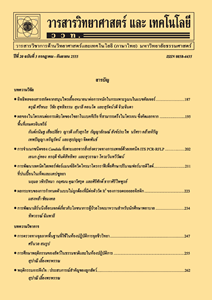การตรวจวัดก๊าซคาร์บอนไดออกไซด์เพื่อตรวจสอบประสิทธิภาพการระบายอากาศภายในห้องเรียน
Main Article Content
Abstract
บทคัดย่อ
การศึกษานี้เป็นการตรวจสอบประสิทธิภาพการระบายอากาศของห้องเรียนในมหาวิทยาลัยแห่งหนึ่งในเขตปริมณฑล โดยเลือกห้องเรียนขนาดความจุ 200 คน จำนวน 3 ห้อง จากอาคารเรียนในกลุ่มสุขศาสตร์ สังคมศาสตร์ และวิทยาศาสตร์ โดยใช้การตรวจวัดระดับความเข้มข้นของก๊าซคาร์บอนไดออกไซด์ในระหว่างที่มีการเรียนการสอนภายในห้องทุก ๆ 5 นาที ด้วยเครื่องมือชนิด non-dispersive infrared analyzer ที่อ่านค่าได้เลยในทันทีจำนวน 2 เครื่อง พร้อม ๆ กัน ค่าที่ได้นำมาเปรียบเทียบกับค่ามาตรฐานของ ASHRAE (American Society of Heating, Refrigerating and Air-Conditioning Engineers) ที่กำหนดให้ภายในอาคารที่มีผู้ใช้งานควรมีระดับก๊าซคาร์บอนไดออกไซด์ไม่เกิน 1,000 ppm อันแสดงถึงการระบายอากาศที่พอเพียงกับจำนวนคนภายในห้อง และมีการคำนวณอัตราการแลกเปลี่ยนอากาศต่อชั่วโมง (air change rate per hour, ACH) เพื่อเปรียบเทียบกับค่ามาตรฐาน ASHRAE ที่กำหนดให้ห้องเรียนควรมีค่าไม่น้อยกว่า 6 ACH ผลการศึกษาพบว่าความเข้มข้นของก๊าซคาร์บอนไดออกไซด์ภายในห้องเรียนกลุ่มสุขศาสตร์อยู่ในช่วง 405-1,243 ppm (จำนวนนักศึกษา 1-73 คน) มีอัตราการแลกเปลี่ยนอากาศเฉลี่ย 0.29-0.37 ACH ขณะที่ห้องเรียนในกลุ่มสังคมศาสตร์พบความเข้มข้นของก๊าซ 395-3,458 ppm (จำนวนนักศึกษา 1-147 คน) มีอัตราการแลกเปลี่ยนอากาศเฉลี่ย 0.35-0.41 ACH ส่วนห้องเรียนในกลุ่มวิทยาศาสตร์พบความเข้มข้นของก๊าซคาร์บอนไดออกไซด์ในช่วง 477-5,310 ppm (จำนวนนักศึกษา 1-175 คน) มีอัตราการแลกเปลี่ยนอากาศเฉลี่ย 0.81-0.85 ACH แสดงถึงการระบายอากาศที่ไม่พอทั้งสิ้น โดยพบการสะสมตัวของก๊าซคาร์บอนไดออกไซด์เพิ่มขึ้นตามเวลาที่ผ่านไปในทุกห้องที่ศึกษา
คำสำคัญ : ก๊าซคาร์บอนไดออกไซด์; การระบายอากาศ; อัตราการแลกเปลี่ยนอากาศ
Abstract
This study investigated the ventilation effectiveness of classrooms in the university in suburb area. Three classrooms for maximum capacity of 200 students were selected from the health science, social science, and science buildings. Carbon dioxide concentrations were monitored every 5 min in the classroom during the session using 2 non-dispersive infrared analyzers which are a direct-reading type in order to compare with the ASHRAE (American Society of Heating, Refrigerating and Air-Conditioning Engineers) standard of 1,000 ppm. Any room that the carbon dioxide concentration does not exceed 1,000 ppm and the air change rate is not less than 6 ACH means adequate ventilation for the numbers of people inside. The study found that carbon dioxide concentration in the health science building’s classroom was in a range of 405-1,243 ppm (with 1-73 students in the classroom) and the average air change rate was 0.29-0.37 ACH. Carbon dioxide concentration in the social science building’s classroom was in a range of 395-3,458 ppm (with 1-147 students) and the average air change rate was 0.35-0.41 ACH. In science building, carbon dioxide in the classroom was found in a range of 477-5,310 ppm (1-175 students) while the average air change rate was 0.81-0.85 ACH. Therefore, the ventilation rates for all classrooms were inadequate. The accumulation of carbon dioxide was also observed from the beginning to the end of each session.
Keywords: carbon dioxide gas; ventilation; air change rate


